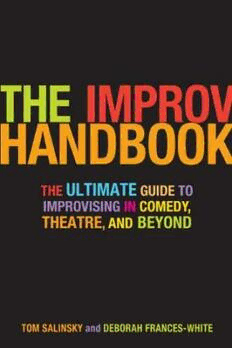Table Of ContentThis page intentionally left blank
NEW YORK • LONDON • NEW DELHI • SYDNEY
Bloomsbury Methuen Drama
An imprint of Bloomsbury Publishing Inc
175 Fifth Avenue 50 Bedford Square
New York London
NY 10010 WC1B 3DP
USA UK
www.bloomsbury.com
First published by Continuum International Publishing Group 2008
Reprinted 2011 (twice), 2012
Reprinted by Bloomsbury Methuen Drama 2013
© Tom Salinsky and Deborah Frances-White 2008
All rights reserved. No part of this publication may be reproduced or
transmitted in any form or by any means, electronic or mechanical,
including photocopying, recording, or any information storage or retrieval
system, without prior permission in writing from the publishers.
No responsibility for loss caused to any individual or organization
acting on or refraining from action as a result of the material in this
publication can be accepted by Bloomsbury or the author.
Visit www.bloomsbury.com to fi nd out more about our authors and their books
You will fi nd extracts, author interviews, author events and you can sign up for
newsletters to be the fi rst to hear about our latest releases and special off ers.
Library of Congress Cataloging-in-Publication Data
Salinsky, Tom.
Th e improv handbook : the ultimate guide to improvising in comedy, theatre, and
beyond / by Tom Salinsky and Deborah Frances-White.
p. cm.
Includes bibliographical references and index.
ISBN-13: 978-0-8264-2859-2 (hardcover : alk. paper)
ISBN-10: 0-8264-2859-2 (hardcover : alk. paper)
ISBN-13: 978-0-8264-2858-5 (pbk. : alk. paper)
ISBN-10: 0-8264-2858-4 (pbk. : alk. paper) 1. Improvisation (Acting)
I. Frances-White, Deborah. II. Title.
PN2071.I5S27 2008
792.02′8—dc22
2008017480
ISBN: HB: 978-0-8264-2859-2
PB: 978-0-8264-2858-5
ePDF: 978-1-4411-0642-1
ePDF: 978-1-4411-0642-1
For my parents
h h h
For Mother and Dad who
encouraged me in all my endeavors.
h h h
And for Patti Stiles,
our mother in improv.
This page intentionally left blank
Contents
Introduction ix
SECTION ONE: “WHAT IS IMPROVISATION?”
1.1 What Was Improvisation? 2
1.2 Improvisation in Performance 6
1.3 History of The Spontaneity Shop 17
Intermission: What Should Improvisation Be? 29
#1: “From Innovation to Art Form” by Deborah Frances-White 29
#2: “Two Stories” by Tom Salinsky 33
SECTION TWO: “HOW TO IMPROVISE”
2.1 How to Use This Section 38
2.2 Teaching and Learning 39
2.3 The Importance of Storytelling 43
2.4 Spontaneity 46
2.5 Saying Yes 54
2.6 What Comes Next 64
2.7 Status 88
2.8 Go Through an Unusual Door 108
2.9 Working Together 124
2.10 Being Changed 143
2.11 Twitching, Topping, and Paperflicking 168
2.12 Playing Characters 175
2.13 You Can’t Learn Mime from a Book 212
2.14 Playing Games 218
2.15 Control Freak 246
2.16 Finding the Game in the Scene 253
2.17 Continue or Thank You 263
2.18 Final Thoughts 268
Intermission: The Rules and Why There Aren’t Any . . . 288
vii
SECTION THREE: “HOW TO IMPROVISE IN PUBLIC”
3.1 Feel the Fear and Do It Anyway 300
3.2 Starting a Company 302
3.3 Nuts and Bolts 307
Intermission: The Paradox of Improvisation 319
SECTION FOUR: “MAKING IMPROVISATION PAY”
4.1 Performing? 326
4.2 Teaching Workshops 328
4.3 Corporate Entertainment 331
4.4 Corporate Training 332
4.5 Corporate Events 334
4.6 How to Get Corporate Work 336
Intermission: Women in Improv 337
SECTION FIVE: “TALKING TO IMPROVISERS”
5.1 Keith Johnstone—The Innovator 342
5.2 Neil Mullarkey—The Comedy Store Player 343
5.3 Randy Dixon—The Synthesizer 347
5.4 Jonathan Pitts—The Impresario 350
5.5 Charna Halpern—The Keeper of the Harold 353
5.6 Mick Napier—Power Improviser 360
5.7 Dan O’Connor—West Coast Legend 363
5.8 Patti Stiles—Our Teacher 367
5.9 David Fenton—Theatresports MC Down Under 374
5.10 Tobias Menzies—The Actor 378
In Conclusion 381
Appendix One: Games 383
Good Games 383
Dumb But Fun 391
Never Play 395
Warm-Up Games 397
Appendix Two: Syllabus 403
Glossary of Terms 405
Thanks 411
Bibliography 413
Index 415
Introduction
What follows is a personal account of the state of the art of comedy
improvisation. In writing this book, we have tried to serve two masters.
On the one hand, we want to give as broad an overview as possible. We
have tackled questions like: Where did improvisation come from? Where
is it going? What is it good for? Who are the major leaders and how do
they differ? Can you make money at it? How?
But, on the other hand, as practitioners of the art with over twenty
years of experience between us, we have also formed some pretty strong
opinions about what works and what doesn’t, what’s helpful and what’s
destructive, what’s positive and what’s negative. Our experience in impro-
visation has mainly been with the school of thought associated with Keith
Johnstone and Calgary, although we have also made it our mission to go
to Chicago and train with people associated with Del Close—notably
Charna Halpern—and Deborah is now an Artistic Associate of the
Chicago Improv Festival. And this book also covers work infl uenced by
Viola Spolin, ideas we have developed ourselves and some material that
doesn’t neatly fi t into any of these categories. Does our longer experience
with Keith make us biased? It depends on how you look at it. On the one
hand, yes, we think that we have found a productive methodology and we
acknowledge the enormous debt we owe to Keith in discovering that. On
the other hand, we don’t feel any particular intellectual loyalty to Keith,
and will be happy to accept, use and steal ideas from anyone. Our mantra
is simply: whatever works.
Our hope is that this personal viewpoint will be appealing and inter-
esting. This book, for better or worse, is our account of what improvisa-
tion is, has been, will be and should be. It is shaped by our experiences
and our history, and if we come across as opinionated, then we hope that
you will be either overjoyed to have found like minds or stimulated by an
opposing argument, or at least made pleasantly aggrieved to have found
people you can entirely disagree with.
ix

